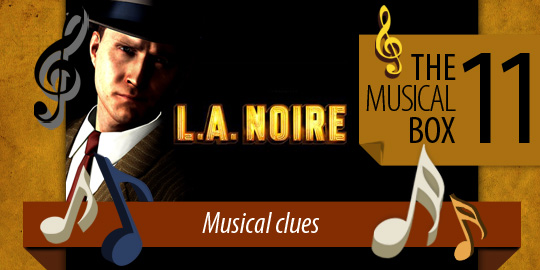Trending
Opinion: How will Project 2025 impact game developers?
The Heritage Foundation's manifesto for the possible next administration could do great harm to many, including large portions of the game development community.
The Musical Box features 30 articles focusing on game music production and implementation. Edition #11: L.A. Noire


Despite the many controversies surrounding its development, it’s hard to deny that L.A. Noire raised the bar for many technical aspects of videogames. At the very least, this crime investigation offering developed by Team Bondi and Rockstar gifted the industry with groundbreaking facial motion capture technology and a beautiful, digital version of L.A. in 1947.
The jazz soundtrack, carefully composed by Andrew Hale and Simon Hale, greatly enhances the mood of that particular period in U.S. history. The developers also did a tremendous job with the implementation. The music not only permeates gameplay, it literally helps the player with the investigation. Keep reading to understand how this happens.
Profile
Game: L.A. Noire
Released: 2011
Platform: PS3, XBOX 360, and PC
Developer: Team Bondi and Rockstar Leeds
Composers: Andrew Hale and Simon Hale
The Set-up
L.A. Noire is an open-world police investigation game. You play the role of Detective Cole Phelps, and you need to do everything that detectives do: analyze crime scenes, find clues, interrogate suspects, chase fugitives and, of course, fight. One of the highlights of the gameplay, and the main subject of this edition of The Musical Box, is the crime scene investigations.
The moment
During crime scene investigations, the player is surprised by a subtle, but very clever, use of music. Basically, an “investigation theme” plays during your search and the song only finishes when you have collected all relevant pieces of evidence. If you leave the crime scene, the music changes to let you know that you must come back and find everything you need to advance in the investigation.
This may be a less aggressive approach to communicating with players, compared to displaying various pop-ups or texts on the screen. If you listen very carefully, you’ll also notice that a very soft note is played on the piano when you’re close to a new piece of evidence. If you have already seen it, a different note is played.
See footage of the first investigation scene in L.A. Noire.
The impact
The combination of subtle music and sound effects increase the player’s immersion. These elements invite you to really pay attention to everything that is around you. L.A. Noire showed us that there are elegant and discreet ways of telling players what is happening in the game.
This technique could be compared to a wall, an invisible wall, so to speak. In an open-world game, there is no explicit differentiation of stages/areas, since the environment is an interconnected world. Each area is differentiated by design, be it different architecture, weather, landmarks, etc. Music can help with this differentiation. Certain themes can be played when the player is getting closer to a region in order to inform them that a change in location or some event is going to occur.
In L.A. Noire’s case, the communication is straightforward, since the tutorial explains why this “investigation theme” was played, but this is just one of the many possible implementations. For instance, you can warn players that a particular area is dangerous by simply switching to a tense musical score.
Depending on the situation, and if used with finesse, this technique can be the opposite of a musical spoiler. Instead of ruining the player’s surprise, you can actually build up the tension by inserting music subtly as the player approaches a certain area. If done correctly, this can greatly improve the impact of your game.
Special thanks: Gilliard Lopes, Rafael Kuhnen, Fernando Secco, Sandro Tomasetti, and Rafael Martins (Sommastudio).
You May Also Like